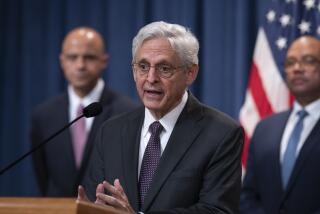15 Held on Charges of Helping Alleged Terrorists Enter U.S.
Federal authorities arrested 15 people Tuesday on charges of operating an immigration fraud ring that helped members of an alleged Iranian terrorist group, among others, enter the United States illegally.
U.S. Atty. Alejandro N. Mayorkas and other law enforcement officials refused, however, to provide any details about infiltration of the country by Mujahedeen Khalq members.
“Our investigation is ongoing,” he said in response to a barrage of reporters’ questions at a Los Angeles news conference attended by officials from the FBI, the Immigration and Naturalization Service and the U.S. State Department.
Mayorkas declined to say how many group members were able to slip into the United States with phony documents or whether they might be planning any violent acts.
“What motive they had for seeking entry to this country we cannot speak to,” he said. “One would hope it’s not for the most nefarious purposes.”
Founded by middle-class Iranian students in the mid-1960s, Mujahedeen Khalq helped the Ayatollah Khomeini topple the shah of Iran and took part in the seizure of the U.S. Embassy in Tehran in 1979.
In the political chaos that ensued, however, the clerics who seized power turned against the students. Mujahedeen leaders fled to France and later found safe haven in Iraq, longtime enemy of Iran, where they are headquartered today.
Although some congressional members have urged the Clinton administration to open talks with Mujahedeen Khalq, the State Department has refused to remove the organization from its list of about 30 international terrorist groups whose members are barred from entering the United States.
The group’s only known action in the United States was a brief takeover of Iran’s mission to the United Nations in 1992. It has been blamed for periodic bombings inside Iran.
According to affidavits prepared by federal agents, the immigration fraud ring operated out of offices on Ventura Boulevard in Encino and provided members of Mujahedeen Khalq and non-terrorist clients with bogus birth certificates, bank and employment records, school transcripts and other documents to obtain student or tourist visas and to win political asylum.
Immigrants seeking asylum were given fabricated stories of persecution to tell INS hearing examiners, the affidavits said.
The alleged ringleader, Bahram Tabatabai, 43, of Sherman Oaks, often appeared with them at their asylum hearings, serving as a translator of Persian. Virtually all the applicants were Iranian. A government affidavit said Tabatabai would sometimes change an applicant’s answer to avoid any possible slip-up.
Tabatabai, a naturalized U.S. citizen born in Iran, attended more than 300 hearings at the INS political asylum office in Anaheim, government records show.
The investigation was launched in 1996 when an employee of Tabatabai’s contacted the FBI. The informant, whose identity was not made public, was described in an investigator’s affidavit as an ex-felon previously convicted of coercion and cheating at gambling in Nevada.
With the informant’s help, the FBI was able to monitor and record conversations between Tabatabai and his clients, including some who allegedly admitted being associated with Mujahedeen Khalq.
Tabatabai was said to have offered two levels of service: one costing $2,500 to $3,000 for coaching on how to obtain a U.S. visa and another costing $8,000 to $12,000 with a guarantee of receiving a visa.
Accused of supplying Tabatabai with forged documents were Mohsen and Mashid Arefe, who operated from a Beverly Hills business called Vijeh Co. The couple later moved to Henderson, Nev., where they were arrested Tuesday.
In addition to those arrested Tuesday, INS officials said they have taken into custody 12 people who entered the country with the fraud ring’s help or had been caught using fraudulent papers. They face deportation.
More to Read
Sign up for Essential California
The most important California stories and recommendations in your inbox every morning.
You may occasionally receive promotional content from the Los Angeles Times.










